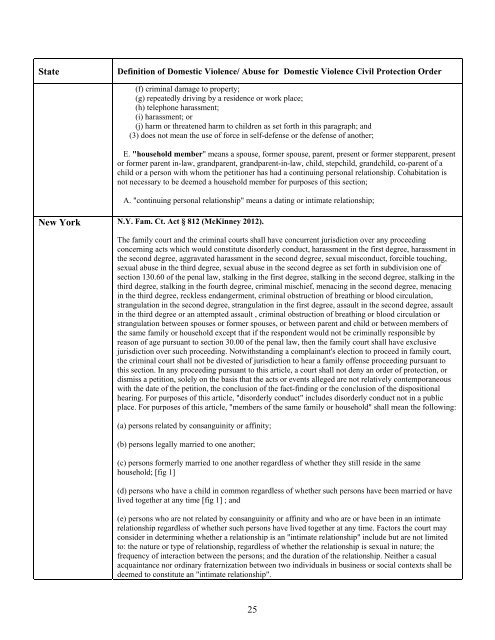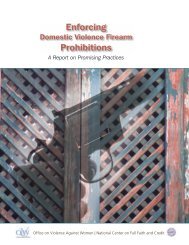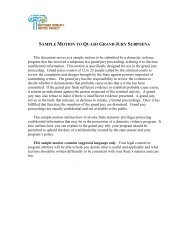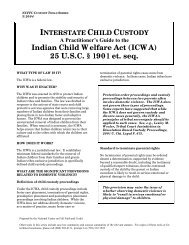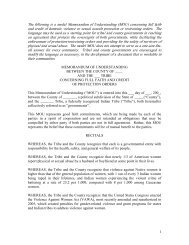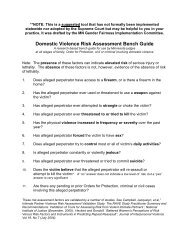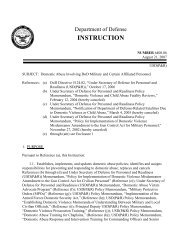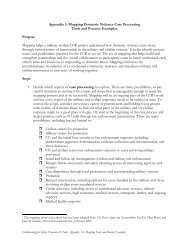Protection Order Definition Matrix - Battered Women's Justice Project
Protection Order Definition Matrix - Battered Women's Justice Project
Protection Order Definition Matrix - Battered Women's Justice Project
You also want an ePaper? Increase the reach of your titles
YUMPU automatically turns print PDFs into web optimized ePapers that Google loves.
State<br />
<strong>Definition</strong> of Domestic Violence/ Abuse for Domestic Violence Civil <strong>Protection</strong> <strong>Order</strong><br />
(f) criminal damage to property;<br />
(g) repeatedly driving by a residence or work place;<br />
(h) telephone harassment;<br />
(i) harassment; or<br />
(j) harm or threatened harm to children as set forth in this paragraph; and<br />
(3) does not mean the use of force in self-defense or the defense of another;<br />
E. "household member" means a spouse, former spouse, parent, present or former stepparent, present<br />
or former parent in-law, grandparent, grandparent-in-law, child, stepchild, grandchild, co-parent of a<br />
child or a person with whom the petitioner has had a continuing personal relationship. Cohabitation is<br />
not necessary to be deemed a household member for purposes of this section;<br />
A. "continuing personal relationship" means a dating or intimate relationship;<br />
New York N.Y. Fam. Ct. Act § 812 (McKinney 2012).<br />
The family court and the criminal courts shall have concurrent jurisdiction over any proceeding<br />
concerning acts which would constitute disorderly conduct, harassment in the first degree, harassment in<br />
the second degree, aggravated harassment in the second degree, sexual misconduct, forcible touching,<br />
sexual abuse in the third degree, sexual abuse in the second degree as set forth in subdivision one of<br />
section 130.60 of the penal law, stalking in the first degree, stalking in the second degree, stalking in the<br />
third degree, stalking in the fourth degree, criminal mischief, menacing in the second degree, menacing<br />
in the third degree, reckless endangerment, criminal obstruction of breathing or blood circulation,<br />
strangulation in the second degree, strangulation in the first degree, assault in the second degree, assault<br />
in the third degree or an attempted assault , criminal obstruction of breathing or blood circulation or<br />
strangulation between spouses or former spouses, or between parent and child or between members of<br />
the same family or household except that if the respondent would not be criminally responsible by<br />
reason of age pursuant to section 30.00 of the penal law, then the family court shall have exclusive<br />
jurisdiction over such proceeding. Notwithstanding a complainant's election to proceed in family court,<br />
the criminal court shall not be divested of jurisdiction to hear a family offense proceeding pursuant to<br />
this section. In any proceeding pursuant to this article, a court shall not deny an order of protection, or<br />
dismiss a petition, solely on the basis that the acts or events alleged are not relatively contemporaneous<br />
with the date of the petition, the conclusion of the fact-finding or the conclusion of the dispositional<br />
hearing. For purposes of this article, "disorderly conduct" includes disorderly conduct not in a public<br />
place. For purposes of this article, "members of the same family or household" shall mean the following:<br />
(a) persons related by consanguinity or affinity;<br />
(b) persons legally married to one another;<br />
(c) persons formerly married to one another regardless of whether they still reside in the same<br />
household; [fig 1]<br />
(d) persons who have a child in common regardless of whether such persons have been married or have<br />
lived together at any time [fig 1] ; and<br />
(e) persons who are not related by consanguinity or affinity and who are or have been in an intimate<br />
relationship regardless of whether such persons have lived together at any time. Factors the court may<br />
consider in determining whether a relationship is an "intimate relationship" include but are not limited<br />
to: the nature or type of relationship, regardless of whether the relationship is sexual in nature; the<br />
frequency of interaction between the persons; and the duration of the relationship. Neither a casual<br />
acquaintance nor ordinary fraternization between two individuals in business or social contexts shall be<br />
deemed to constitute an "intimate relationship".<br />
25


